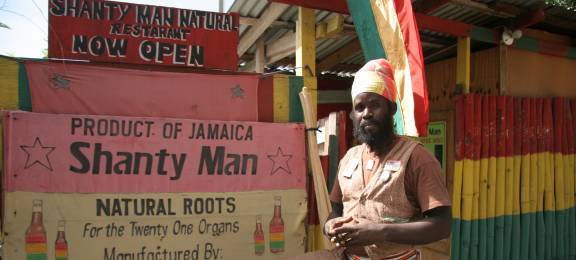The outdoor amphitheatre at Edna Manley College of the Visual and Performing Arts hosts poetry readings on the last Tuesday of every month starting at 7:30 p.m.; regular dance performances are held in the indoor theatre next door.

Call or email for assistance planning your trip: +1 (212) 203-0064 | reservations@moonjamaica.com
The outdoor amphitheatre at Edna Manley College of the Visual and Performing Arts hosts poetry readings on the last Tuesday of every month starting at 7:30 p.m.; regular dance performances are held in the indoor theatre next door.
Phillip Sherlock Centre for the Creative Arts puts on UWI productions, including those of the student dance society. The building that houses the arts center is architecturally impressive.
Island Art & Framing sells a wide variety of local and imported arts and crafts and can frame just about anything.
Revolution Gallery (10 a.m.–6 p.m. Mon.–Fri., 10:30 a.m.–3 p.m. Sat.) has some exceptional crafts as well as excellent work by Jamaican painter Natalie Barnes, among many more.
The Rock Tower (9 a.m.–5 p.m. Mon.–Fri.) also known as ROKTOWA by the artists, is an inner-city gallery that helps develop local talent by encouraging linkages between practical art and export markets. Creative Director Melinda Brown brought the concept from her pioneering studio in New York City's Meatpacking district to Downtown Kingston, where she continues her crusade for urban renewal through community art. ROKTOWA artists work in oil, clay, and alabaster, among other materials.
The National Gallery (10 a.m.–4:30 p.m. Tues.–Thurs., 10 a.m.–4 p.m. Fri., 10 a.m.–3 p.m. Sat., closed Sun. and Mon., US$1.15 adults, US$0.55 students and persons 65 and over) is the go-to place for a concise overview of Jamaican art, from Taino artifacts and colonial art dating to Spanish and English rule, to pieces charting the development of Jamaican intuitive and mainstream expressions. The works at the National Gallery reflect Jamaica's landscapes and its people, and their history, religion, spirituality, and folklore.
The Art Centre (9 a.m.–5 p.m. Mon.–Fri., 10 a.m.–4 p.m. Sat., free admission) is housed in a uniquely designed apartment building commissioned by A. D. Scott in the 1960s. Inside, colorful murals adorn the walls and art is displayed on the upper two levels as part of the building's permanent collection. The gallery uses the ground floor space for its transitory exhibits. Rosemarie Thwaites is the gallery director. Paintings start around US$100. On the same compound there is an art supply and framing shop.
Grosvenor Gallery has contemporary art exhibits and occasional crafts fairs that brings artists and craftspeople from around Jamaica. Call for upcoming events.
Sanaa Studios (10 a.m.–5 p.m. Mon.–Fri., 10 a.m.–2 p.m. Sat.) offers classes in ceramics, drawing, painting, art photography, and jewelry making. A small gallery has a steady flow of exhibits by students and others. Drop-in rates are US$20–35 for three-hour sessions.